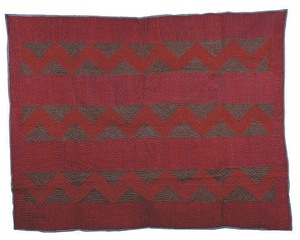

One of Margaret Ann Buckley Gobble's linsey-woolsey quilts. (Photo by James H. Price)
It was 1847 in Southwest Virginia, just outside Abingdon. Margaret Ann Buckley and Martin Gobble wanted to get married but were encountering some opposition from their parents.
So they eloped. In those days this meant by horseback, which is just what Margaret Ann and Martin did that June day of their wedding, riding 40 miles to Blountville, Tenn., where the preacher waited. The extra effort must have been worth it, and their families must have forgiven them, for they soon had a farm adjoining Martin's parents and a lasting marriage with 13 children.
By this time - mid-19th century - Martin was the third generation of his family in Washington County, Va. His great-grandparents had emigrated from Germany to Pennsylvania in 1739, settling first in Philadelphia and then in Frederick, Md. They spelled their name Gabel, but before finally arriving in Washington County, like many new Americans they had changed it, in their case to Gobble. Family history says it was the good hunting to be found in the Virginia mountains that prompted Martin's great-grandfather, Christian, to bring his family west. He was not alone in his move. His half-brother, Frederick, also moved to Washington County where he and Christian established farms near one another a few miles north of Abingdon and not far from the North Fork of the Holston River.
This naturally resulted in a big extended family of grandparents, uncles, aunts and lots of cousins. They raised sheep on their farms and grew flax in the fields. Mountain winters were cold, and most families turned to their sheep and flax to make warm fabric that has become a signature textile for the chilly climate of 19th-century Southwest Virginia. Spinning wool and flax into yarn and then weaving it together on their looms, the Gobble women, including Margaret Ann, fashioned sturdy bed coverings and clothes for their families.
The sturdiest of their woven fabrics was often called linsey-woolsey, some say taking its name from Lindsey, the Suffolk, England, village where it was first produced. The combination of linen and wool made it strong, warm and coarse, and many who remember sleeping under it also add, "scratchy." If two pieces were put together with batting in between, the resulting bedcover was called a linsey-woolsey quilt. Extremely warm, it was well-suited to winters in Southwest Virginia.
Margaret Ann Gobble and her family made many beautiful textiles from their sheep and flax, from one-ply overshot coverlets to linsey-woolsey quilts like the one shown here. Its walnut-dyed brown and madder-red color scheme is shown off by a striking pieced pattern of zig-zags, triangles and squares. The whole, with batting in between, is joined to a backing with fancy quilting stitches. This stunning linsey-woolsey quilt is one of two saved and treasured by Margaret Ann's descendants ... rare intact examples of this 19th-century quilt form.
Margaret Ann Gobble, Spinner and Weaver is taken from "Backcountry Makers: An Artisan History of Southwest Virginia & Northeast Tennessee." This is the 14th in a series of articles related to this new book by Betsy K. White. Featuring more than 200 color images, it is newly published by the University of Tennessee Press. "Backcountry Makers" is White's second book on the history of the region's material culture. The first, "Great Road Style: the Decorative Arts Legacy of Southwest Virginia & Northeast Tennessee," was published in 2006 by the University of Virginia Press. "Backcountry Makers" is now available locally in Abingdon at Zazzy'Z Coffee House &Bookstore and at Heartwood: Southwest Virginia's Artisan Gateway or online from the University of Tennessee Press or Amazon.com.